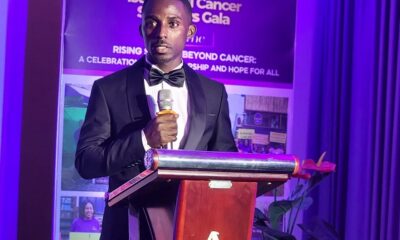Features
This question of love
Published
2 months agoon
The question of love is something that will be talked about until kingdom come.
A discussion I observed on the internet about a 19 year old who had accepted the proposal of a 67 year old man reminded me of the preaching of Pastor Mensa Otabil.
He talked about the a scenario where a 60 year old man enters into a relationship with a 22 year old lady and the lady tells him I love you, when he has a protruded belly, with all the accompanying creases and he believes what she says.
He further went on to say that a whole grown up man, allows a young lady to call him “babe” and he does not feel offended.
He further went on to preach that, this young lady, young enough to be his daughter, says “babe, I love you” and this man sheepishly laughs and does not realise, he is being taken advantage of.
What keeps ringing in my ears is his statement that “what is there to love about a protruding sagging belly?”
There is no regulated way for how a person falls in love. It reminds me of a funny statement that Pastors or marriage counsellors often use, that if you fall in love, you may hurt yourself.
Love I believe is a beautiful thing but it is not something that should be toyed with. People getting into relationships should consider the realities that are bound to happen as the years go by.
Jealousy is a very destructive influence. It can influence a person to harm his wife or her husband or to even commit murder. There has been countless reported instances where a man has poured acid on his wife or girlfriend, slashed his wife to death with a cutlass because he suspected, the wife was cheating on him.
It is something that blinds one to right reasoning and once your reasoning stops functioning, then the wrong side of us takes over and the result is nothing to write home about. In most cases, it comes out after the horrible act has been perpetrated, that there was no truth in the issue that caused the jealousy, after all. However, a life would have been maimed, disfigured or destroyed forever.
One of the causes of jealousy in marriage is the age gap difference. Whether we like it or not we shall grow old one day if God by his grace enables us to live long. When we grow old, a lot of changes occur in our bodies and things we used to do with ease, suddenly become a huge challenge and it could be very frustrating.
One of the things that drives a man crazy is when he has grown weaker in bed and sees the wife interacting with younger men in a suspicious manner that seems to suggest that there is more to it than meets the eye.
Jealousy will definitely be kindled in the heart of such a man whose wife is far younger than him like this 67 year old man wanting to marry a 19 year young lady.
In 30 years’ time, this man will be 97 and his muscles would have become weaker affecting his erection. His wife would be 49 and will have to be satisfied in bed in a manner that this man cannot execute. What do you think is going to happen?
Marriage Counsellors advocate that the ideal age gap between marriage partners should not be more than 10 years. This is one way to eliminate suspicions which results in mistrust when the man grows old and gets weaker because it is a known fact that sex is very important to men than women.
A man becomes very worried when his sexual performance level drops. This is what causes some men to act in a manner that is condemnable. My advice, walk into love, don’t fall into it. God bless.
NB: ‘CHANGE KOTOKA INTERNATIONAL AIRPORT TO KOFI BAAKO INTERNATIONAL AIRPORT
You may like
Carcinoma is a type of cancer that originates in epithelial cells, which are the cells that form the lining of organs and glands.
It is the most common type of cancer, accounting for approximately 90 per cent of all cancer cases. Carcinoma can occur in various parts of the body, including the skin, lungs, breast, colon, and prostate.
Types of Carcinoma
There are several subtypes of carcinoma, each with distinct characteristics and prognoses. Some of the most common types of carcinoma include:
1. Squamous cell carcinoma: This type of carcinoma originates in the squamous cells, which are the flat, thin cells that form the lining of organs and glands.
2 : This type of carcinoma originates in the glandular cells, which are the cells that form the lining of glands and organs.
3. Basal cell carcinoma: This type of carcinoma originates in the basal cells, which are the cells that form the lining of the skin and other organs.
4. Transitional cell carcinoma: This type of carcinoma originates in the transitional cells, which are the cells that form the lining of the bladder, ureters, and renal pelvis.
Causes and risk factors
The exact causes of carcinoma are not fully understood, but several risk factors have been identified. These include:
1. Genetic mutations: Carcinoma can be caused by genetic mutations, which can be inherited or acquired.
2. Environmental factors: Exposure to environmental carcinogens, such as tobacco smoke, radiation, and certain chemicals, can increase the risk of developing carcinoma.
3. Age: The risk of developing carcinoma increases with age.
4. Family history: A family history of carcinoma can increase an individual’s risk of developing the disease.
Symptoms and diagnosis
The symptoms of carcinoma can vary depending on the location and type of cancer. Common symptoms include:
1. Unexplained weight loss
2. Fatigue
3. Pain
4. Changes in bowel or bladder habits
5. Unusual bleeding or discharge
Carcinoma is typically diagnosed using a combination of imaging tests, such as X-rays, CT scans, and MRI scans, and biopsy, which involves removing a sample of tissue for examination under a microscope.
Treatment Options
The treatment options for carcinoma depend on the type, location, and stage of the cancer. Common treatment options include:
1. Surgery: Surgery is often used to remove the cancerous tumor and surrounding tissue.
2. Chemotherapy: Chemotherapy involves using medications to kill cancer cells.
3. Radiation therapy: Radiation therapy involves using high-energy rays to kill cancer cells.
4. Targeted therapy: Targeted therapy involves using medications that target specific molecules involved in cancer growth and progression.
Prevention and early detection
Preventing carcinoma involves avoiding known risk factors, such as tobacco smoke and environmental carcinogens, and getting regular cancer screenings. Early detection of carcinoma can significantly improve treatment outcomes.
Conclusion
Carcinoma is a complex and multifaceted disease that requires a comprehensive approach to diagnosis, treatment, and prevention. By understanding the causes, risk factors, symptoms, and treatment options for carcinoma, individuals can take steps to reduce their risk of developing the disease and improve their chances of successful treatment.
References:
1. “Carcinoma” by the American Cancer Society
2. “Carcinoma: A Review of the Literature” by the National Cancer Institute
3. “Carcinoma: Diagnosis, Treatment, and Prevention” by the World Health Organization
Carcinoma is a type of cancer that originates in epithelial cells, which are the cells that form the lining of organs and glands.
It is the most common type of cancer, accounting for approximately 90 per cent of all cancer cases. Carcinoma can occur in various parts of the body, including the skin, lungs, breast, colon, and prostate.
Types of Carcinoma
There are several subtypes of carcinoma, each with distinct characteristics and prognoses. Some of the most common types of carcinoma include:
1. Squamous cell carcinoma: This type of carcinoma originates in the squamous cells, which are the flat, thin cells that form the lining of organs and glands.
2 : This type of carcinoma originates in the glandular cells, which are the cells that form the lining of glands and organs.
3. Basal cell carcinoma: This type of carcinoma originates in the basal cells, which are the cells that form the lining of the skin and other organs.
4. Transitional cell carcinoma: This type of carcinoma originates in the transitional cells, which are the cells that form the lining of the bladder, ureters, and renal pelvis.
Causes and risk factors
The exact causes of carcinoma are not fully understood, but several risk factors have been identified. These include:
1. Genetic mutations: Carcinoma can be caused by genetic mutations, which can be inherited or acquired.
2. Environmental factors: Exposure to environmental carcinogens, such as tobacco smoke, radiation, and certain chemicals, can increase the risk of developing carcinoma.
3. Age: The risk of developing carcinoma increases with age.
4. Family history: A family history of carcinoma can increase an individual’s risk of developing the disease.
Symptoms and diagnosis
The symptoms of carcinoma can vary depending on the location and type of cancer. Common symptoms include:
1. Unexplained weight loss
2. Fatigue
3. Pain
4. Changes in bowel or bladder habits
5. Unusual bleeding or discharge
Carcinoma is typically diagnosed using a combination of imaging tests, such as X-rays, CT scans, and MRI scans, and biopsy, which involves removing a sample of tissue for examination under a microscope.
Treatment Options
The treatment options for carcinoma depend on the type, location, and stage of the cancer. Common treatment options include:
1. Surgery: Surgery is often used to remove the cancerous tumor and surrounding tissue.
2. Chemotherapy: Chemotherapy involves using medications to kill cancer cells.
3. Radiation therapy: Radiation therapy involves using high-energy rays to kill cancer cells.
4. Targeted therapy: Targeted therapy involves using medications that target specific molecules involved in cancer growth and progression.
Prevention and early detection
Preventing carcinoma involves avoiding known risk factors, such as tobacco smoke and environmental carcinogens, and getting regular cancer screenings. Early detection of carcinoma can significantly improve treatment outcomes.
Conclusion
Carcinoma is a complex and multifaceted disease that requires a comprehensive approach to diagnosis, treatment, and prevention. By understanding the causes, risk factors, symptoms, and treatment options for carcinoma, individuals can take steps to reduce their risk of developing the disease and improve their chances of successful treatment.
References:
1. “Carcinoma” by the American Cancer Society
2. “Carcinoma: A Review of the Literature” by the National Cancer Institute
3. “Carcinoma: Diagnosis, Treatment, and Prevention” by the World Health Organization
By Rober Ekow Grimmond-Thompson
Features
A focus on Mrs Adjoa Brewu, the first Ghanaian migrant to be elected in Finland
Published
2 weeks agoon
April 26, 2025I continue with my narration of personalities and their accomplishments as members of the Ghanaian Diaspora in Finland, with a focus on Mrs Adjoa Brewu.
Mrs Brewu won in the Municipal elections in Finland four years ago. She is the daughter of the late Sir Wilberforce Essandor, the versatile elder in the Ghanaian community in Finland, who died in Finland in 2021.
Accomplishments and honours
It is important to recount accomplishments as part of the success stories of the personalities of Ghanaian descent in Finland to highlight their exploits both within the Ghanaian migrant community and in the wider Finnish society.
Mrs Brewu was the first Ghanaian migrant to be elected as a Deputy Councillor in the Finnish elections in 2021. Recently, another Ghanaian migrant, Lukumanu Iddrissu, has become the first Ghanaian to be elected as a Councillor in this month’s (April 2025) elections. This feat thus goes a step further. I hope to do a write-up on his story in due course.
Even so, in terms of the achievement of being elected in elections in Finland, Mrs Brewu is arguably a trailblaser within the Ghanaian migrant community. She however did not stand in this April 2025 elections.
Education and employment exploits
In Ghana, Mrs Brewu went to Fijai Senior High (then Secondary School) in Takoradi, and graduated from the Central University with a Bachelor of Sciences in Business Management and Administration, Human Resources Management (from 2000 to 2004). She then did national service in one of the banks in Ghana.
After that, Mrs Brewu came to Finland in 2007 and did a Master’s degree in Economics, obtaining an MSc Econs with International Management as her major.
She learned the Finnish language and undertook an internship position at the HR Department of the Espoo City Central Administration.
Mrs Brewu later worked at the Education sector of Espoo City and also at the Finnish Elementary Education Unit as an Assistant in the Language and Culture department, which is in charge of the placement of foreign students arriving in Finland as well as native language training for those who speak Finnish as a second language.
From there, she became the Coordinator of multicultural affairs in the Youth and Sports unit at Espoo City as part of integrating immigrants and helping them to actively participate in the Finnish society. In what can be seen as a two-way affair, she helped to introduce the Finnish culture to immigrants (foreigners) while introducing immigrants’ original cultures to the Finnish audience.
Political interests and achievements
Mrs Brewu was long harbouring the desire to enter into politics in Finland but did not give it any strong thoughts until around 2017. As she told me, in 2017 someone contacted her to stand in the Finnish Municipal elections. She obliged and stood, but she lost in that elections.
She stood again in 2021, encouraged by her father, Mr Essandor. She won this time around and became a Deputy Councillor. The victory was unique and hard won on the ticket of the relatively small and conservative Christian Democrats Party (Suomen Kristillidemokraattinen Puolue, KD).
The victory was also a huge consolation not just to herself and family, but also to the entire Ghanaian migrant community as her father, Mr Essandor, a Patron of the Ghana Union Finland as an association representing Ghanaian immigrants in Finland, had died a few weeks earlier in May that year.
Religious life
Mrs Brewu is a prominent member of the Methodist Church in Finland. She plays an active role in the church as the National Head of the Youth Ministry.
Mrs Brewu also coordinates international work in her local congregation and serves as an interpreter in church events as well as sings in the choir.
Her role in the Ghanaian community
As mentioned earlier, Mrs Brewu is very active in the Ghanaian community. She is almost always seen in events organised by the Ghana Union Finland, the non-governmental organisation for the Ghanaian migrant community in Finland.
She is no doubt a role model for many within the Ghanaian migrant community in Finland, especially the young ones. She has passion for empowering young people of immigrant descent and promoting the integration of adult immigrants through work.
Mrs Brewu lives in Espoo, a part of the larger Helsinki Metropolitan area, with her husband and children.
In conclusion, I would say Mrs Brewu has succeeded in embossing her name among the firsts in Finnish politics and within the Ghanaian community.
Email: perpetual.crentsil@yahoo. com
By Perpetual Crentsil

National Peace Council pays courtesy call on Minister for Foreign Affairs

Jerry Afriyie Departs Camp to Rejoin Club in Spain

Italian delegation pays courtesy call on health minister to advance retooling project for 37 hospitals
Trending

 Politics8 months ago
Politics8 months agoVoter Register Discrepancies: NDC to stage nationwide protests against EC

 News9 months ago
News9 months agoArise Royals Montessori School Marks 2nd Graduation.

 Entertainment10 months ago
Entertainment10 months agoGhanaian musician Champions Gaza Peace with New Track

 News5 months ago
News5 months agoKing of Igbo Community in Ghana congratulates Mahama as President-elect of Ghana.

 More9 months ago
More9 months agoYoung people urged to develop their talents

 News10 months ago
News10 months agoCancer Support Network Foundation holds gala

 Entertainment10 months ago
Entertainment10 months agoSteps to receive an official GWR certificate – Details from mother of a Ghanaian record holder

 Tech10 months ago
Tech10 months agoWatch out for sharks: The bizarre history of internet outages

















